Pacific Crossing, Tender woes and The Bay of Penises 10° 30’S 138° 41’W

|
10° 30’S 138° 41’W Pacific Crossing, Tender woes and The Bay of Penises Some friends have asked why we have not updated our blog going across The Pacific. I
guess one of the reasons is that we had such an easy, albeit relatively slow
crossing. After crossing the equator and eventually picking up the steady South
Easterly trade winds we were simply ‘blown across’ the ocean. We relaxed, read
a lot, tried to catch fish, kept up our regular watch routine, went on the SSB
short wave radio net, did a few maintenance jobs, Caroline baked bread and
yummy cakes, we played backgammon and most importantly really enjoyed our time
together and the whole ocean crossing experience The only fish we caught was a 10kg black fin tuna, which for two persons provides a lot of meals. A number of fish got away (yes they really did!) or simply bit the whole lure off. We nearly landed a dorado or mahi-mahi on two occasions, but alas on the crest of a wave, when we could see them, they got away. Asked
if it was dangerous, we have to say no, not at all, but after we made landfall
trying to get ashore in our tender was without doubt the most perilous
operation of the whole trip! We made landfall in Hiva Oa an island in a group
known as The Marquesas in French Polynesia on Tuesday 02 June after 32 days at
sea and covering nearly 3900nm. That is about 4485 land miles. We sailed nearly
the whole way, only using the engine for a total of 20 hours, mainly in The
Doldrums. Hiva Oa is the second largest island of the Marquesas and an official
port of entry. After setting two anchors, one forward and one at the stern to
keep us into wind and to stop us swinging in the relatively busy anchorage we
celebrated with a bottle of champagne followed by a couple of beers. And then
to sleep, as after so many nights of three hours on and three hours off watch
we were both very tired. The anchorage had quite a swell, and the landing place for the tender consists of a concrete block with a concrete slab about 1 metre above it to cater for the tidal range. To tie the tender up we needed to use our small grapnel anchor to hold it off the concrete block and prevent it being washed under the slab and on to the rocks. The whole process, with the wash moving you all over the place trying to tie up and get ashore was not easy. Having clambered back in, whilst trying to move out of the way of fellow yachties trying to get ashore, our little tender anchor stopped holding just as we were hit by some wash. We were pushed by the swell with some force under the concrete slab, Caroline hit the side of her head and face and Michael hit his arms trying to fend off. Very luckily we escaped with no more than grazes and bruising. After sailing so far without mishap, it was ironic that our only problem was with the tender. Checking in was a case of walking about 40 minutes to the small village and going to the Gendarmerie. We filled in a form, a friendly female officer took copies of our passports stamped the form and then told us to go to the post office and post it to the customs office in Tahiti. We needed 75 cents, but we could not pay. The currency here is the Pacific French Franc, but due to a planned power cut that day, the bank was closed and the ATM at the post office was not working. The same in the little supermarket, the card machine was not working and no they did not take US dollars or even Euros. We had to return empty handed and come back another day. Only the Gendarmerie had some sort of back-up power. We spent 6 days in the anchorage, had some chats with other yachties, including a Swedish guy of 74 who did not want to go through The Panama Canal and sailed round Cape Horn to get here. Now that is serious sailing! We hired a little Suzuki jeep one day to explore the island, some of the very interesting archaeological sites and some amazing scenery. It is an interesting place, the culture very much still Polynesian but with back up of French infrastructure. The artist Gauguin lived here for the last years of his life and we visited an exhibition of copies of his works. Marquesan is the local language, but everybody speaks French and a few also speak English. Our next island is called ‘T’ Island by some sailing friends as they say nobody can pronounce it. The island is called Tahuata. We anchored in the North West corner in a bay on our own and dived in the water to look at the yacht. All sorts of things were growing underside the hull despite the so called copper coat, ‘stops everything’ anti-fouling. Working with scrapers, each of us taking a side each, we eventually got the hull looking reasonable again. We spent about a week in different bays on this island and went ashore at a small village of Hapatoni in the South. The main village of Vaitahu was having some work done to the small dock and we could not find a suitable place to land the dingy due to the wash and being forewarned after our previous tender woes. We
walked and chatted to some local people and went into the village shop. The
shelves were bare, the only thing they seemed to have was powdered milk. Do you
have any pamplemousse, a type of mouth wateringly delicious large grapefruit, we
asked. No but I will get you some. A few minutes later after sending a young
man to climb a tree she returned with the pamplemousse. We asked how much, but
she refused money, saying they grew here and we could have them. We tried to sail to our next island, Fatu Hiva, but were beaten back by winds gusting up to 43 knots, (approximately 50mph) and right on the nose. Impossible, so we went back to Hiva Oa to explore the bays on the North Coast. One night was spent in Hanaiapa Bay a place we called Head Bay, due to a huge rock formation in the bay which looked like a head. We tried to get ashore, but the small landing stage was not suitable in the swell we encountered. Luckily the village of Hanaiapa ashore was one we had driven to on our land- based excursion. The next day we anchored in Puamau bay and the following morning visited the village and the best archaeological site on the island. It has one of the largest Tiki in French Polynesia as well as several others. We found a small shop to top up, at a price, with essentials; we had run out of beer! The alarm the next morning was set for 04:30. We motored out of the bay and round the North East headland. It was hard going for a while motoring into the waves, bang, bang as we hit the steep seas. Having got into deeper water things improved and we then had the right angle to sail all the way to Fatu Hiva. We arrived in The Bay of Virgins Fatu Hiva just after lunchtime. The landscape is spectacular with basaltic spires towering up above the tropical forest and palm trees. The original name for the bay was the Bay of Penises (baie des verges), but the Catholic missionaries when they arrived, soon changed that! Anchoring was not easy and after about 4 or 5 attempts, we settled for deeper water, putting out over 80 metres of chain. Our chain after about 55 metres becomes a little rusty so we attached an extra warp to the chain with a shackle for safety. Fatu Hiva is a spectacular island and one of our highlights was an hour-long walk up to a magnificent waterfall. Water cascaded down a rock face into a small pool. We stripped off and dived in, it felt so good to swim in cool fresh water in such a totally remote place. We are very privileged to be able to visit a part of the world so beautiful and yet visited by so few. S/Y Golden Spirit of Islay 21 June 2015 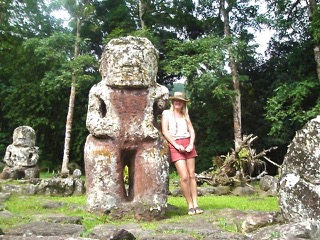  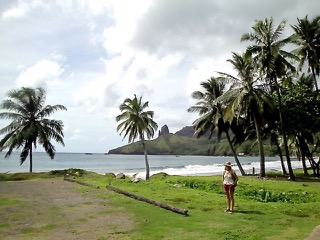 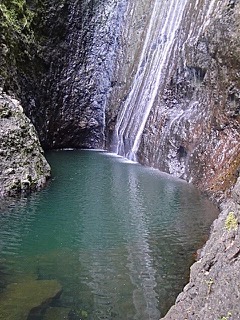 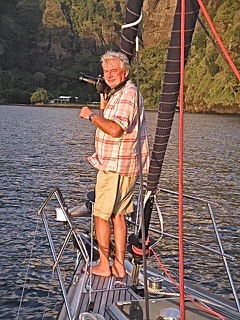  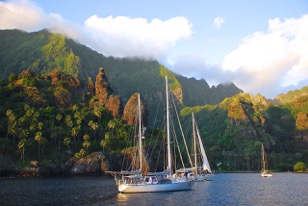 |